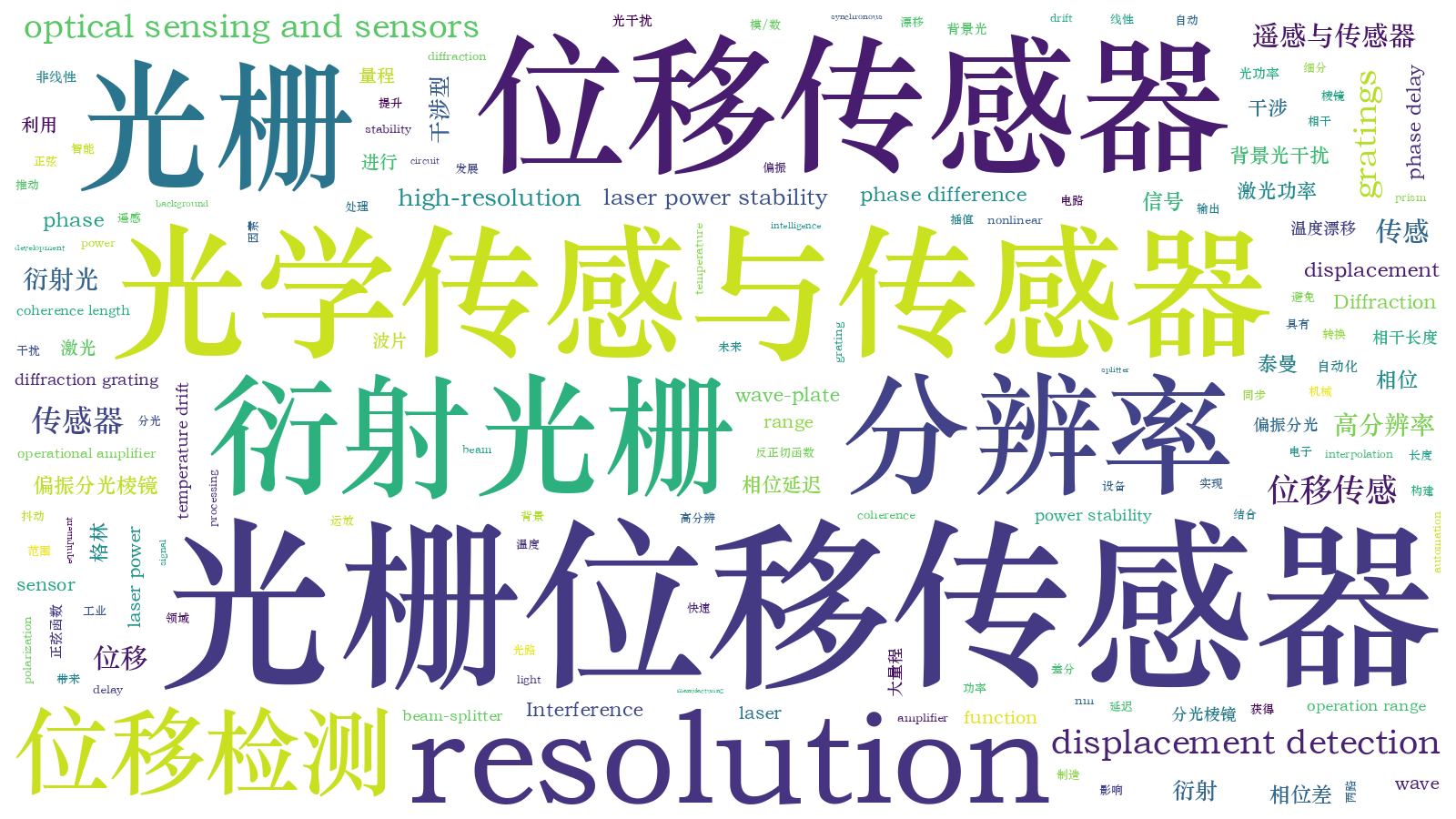泰曼-格林干涉型衍射光栅位移传感器  下载: 1151次
下载: 1151次
1 引言
微位移检测作为一种核心技术已被广泛应用在各类传感器中,比如加速度计、陀螺仪及生化传感器等。以加速度计为例[1],虽然施加的加速度会导致质量块产生相对位移,但由于集成电路的工艺兼容性好,因此到目前为止,绝大多数微电子机械系统(MEMS)传感器仍采用电容方式来检测微位移。随着集成化电容式传感器的发展,其信噪比(SNR)随着体积的减小而大幅降低[2],并且电容存在下拉效应,极板的最大可移动距离只有基板初始间距的三分之一。目前,衍射光栅被大量应用于各种位移传感以及角度测量领域[3-4],此外,它还以不受下拉效应约束和对电磁干扰免疫等优势而被广泛应用在MEMS器件中。1992年,美国斯坦福大学的Solgaard等[5]首先利用衍射光栅在MEMS器件中实现了位移测量,他们利用光栅衍射产生的反射光与透射光获得光程差,采用静电驱动方式研制出了MEMS光学调制器。在此之后,该方法被广泛运用到各类光学MEMS传感器中,并获得了很大改进。2002年,美国佐治亚理工学院的Hall等[6]首次利用该原理与静电力控制相结合制备出了声学换能器(cMUT),之后该团队又成功地在单个结构上分别集成了光电池[7]和VCSELS(vertical cavity surface emitting laser)光源[8],并成功制备出原子力显微镜探针[9];2016年,他们通过设计具有不同高度的光栅来减少零级反射光,以避免反射光对激光器稳定性的影响[10];此外,他们在静电力控制光栅和反射镜间距[11]等方面也作出贡献。2007年,土耳其KOC大学的Ferhanoglu等[12-14]提出了利用双波长光源将测量量程由105 nm提升至1.7 μm的方案。2009年,清华大学的研究人员[15-19]在单个衬底上成功制备出了具有不同高度的双光栅结构,他们利用不同高度光栅产生两个具有固定相位差的衍射光斑,交替使用衍射光斑有效避免了光强在峰值(或谷值)处灵敏度低的缺点,并成功地将此结构应用到生化检测中。2011年,浙江大学的研究人员将此原理应用到加速度计中[20-21],并采用锁相放大技术提高了SNR[22-24]。2019年,北京航空航天大学的刘迪等[25]利用通电线圈产生电磁力完成了光栅加速度计的线性驱动,简化了设计结构并有效降低了驱动电压。
尽管上述方法在扩大量程范围和提高分辨率等方面获得了很大进展,但量程范围依然较小,无法满足一些大量程的应用需求。鉴于此,本文将波片与偏振分束棱镜相结合产生了四路相位差为90°的正/余弦信号,然后对两路相位差为180°的信号进行差分处理,以有效降低背景光和光电二极管的暗电流对位移传感器精度的影响,最后利用反正切算法对四路具有90°相位差的信号进行非线性模/数(A/D)转换,实现了2.54 nm的位移分辨率,同时将衍射光栅位移传感器的量程范围由激光波长的四分之一提升至激光相干长度的二分之一。
2 泰曼-格林型衍射光栅位移测量原理
2.1 衍射光栅位移测量原理
基于衍射光栅的位移测量原理如

图 1. 衍射光栅位移测量原理示意图
Fig. 1. Schematic of principle of diffracted-grating displacement measurement
对于前三级衍射光,其干涉光强与位移的关系分别为[26]
式中:Iin表示入射激光的光强;I0、I±1、I±3为相应级次的干涉光强;d表示反射镜与光栅之间的间距;λ为激光器的波长。由于衍射光强I随d呈正弦变化(如

图 2. 前三级衍射光强随位移d的变化
Fig. 2. Variation of normalized diffraction intensity of the first three orders with displacement d
2.2 泰曼-格林型干涉光路设计
为解决该光路结构量程较小的问题,在该光路中引入泰曼-格林型相移系统,将波片和偏振分光棱镜相结合,获得四路相位差为90°的正弦信号,如
根据琼斯运算,光电探测器PD1、PD2、PD3、PD4接收到的光强依次为[27]
式中:ϕ1表示透射光引入的相位参量;ϕ2表示反射光引入的相位参量;E0为光到达偏振分光棱镜前的光矢量的合成复振幅。根据分析可知,通过泰曼-格林型同步相移系统可将光强随位移呈正弦变化的信号变为四路随位移变化的相位差为90°的正弦信号。
3 直流偏置对反正切算法的影响及实验验证
通过泰曼-格林型同步相移系统可形成四路相位差为90°的正弦信号。为提高位移传感器的分辨率和线性度,本文采用反正切算法对正弦函数进行线性化处理,并对反正切函数进行A/D转换,以提高系统的分辨率。利用Simulink对反正切算法进行仿真,如

图 4. 反正切算法的Simulink仿真。(a)反正切算法的Simulink建模;(b)正/余弦函数的Simulink仿真结果;(c)取绝对值的Simulink仿真结果;(d)正切函数的Simulink仿真结果;(e)反正切函数的Simulink仿真结果
Fig. 4. Arctangent algorithm Simulink simulation. (a) Modeling of arctangent algorithm in Simulink; (b) Simulink simulation of sine/cosine function; (c) Simulink simulation of absolute value; (d) Simulink simulation of tangent function; (e) Simulink simulation of arctangent function
由反正切算法原理可知,两路相位差为90°的正弦信号也可构建反正切函数,但是需要准确提供正弦信号的偏置电平,否则会对细分插值精度产生影响,如

图 5. 偏置误差对反正切的影响。(a)无偏置误差与存在1%偏置误差条件下反正切值仿真结果的对比; (b) 1%偏置误差下产生的反正切误差
Fig. 5. Effect of offset error on arctangent. (a) Comparison of arctangent value of without offset error and with 1% offset error; (b) arctangent error value with 1% offset error
为保证获得更高的位移分辨率,本文选用四路相位差为90°的正/余弦函数构建反正切函数,并进行A/D转换,以提高位移传感器的线性度和分辨率。由于波片厚度会不可避免地存在误差,并且波片快轴方向无法与理论状态完全一致,因此光路输出会不可避免地存在相位误差。再加上光电探测器会因光电转换效率存在个体差异而导致输出存在幅值误差,这两者都将直接影响细分插值的精度。实际光路输出中存在小于0.05 rad的相位误差以及小于1%的幅值误差,经Simulink仿真分析可知,二者同时存在时最高可对正/余弦输出信号进行128倍细分插值。通过对比定位系统的位置反馈与不同倍数的输出结果,最终选择插值倍数为125,具体实验装置图如

图 6. 验证分辨率实验装置图(L:激光器;PL:偏振片;PI:P-611线性压电陶瓷定位系统;IC:插值细分电路)
Fig. 6. Experimental setup of resolution verification (L:laser; PL: polarized light polariscope; PI: P-611 linear piezoelectric ceramic positioning system; IC: interpolation circuit)

图 7. 插值细分电路的位移误差分析。 (a) 压电陶瓷定位系统反馈与内插电路位移输出的对比;(b)误差分布曲线
Fig. 7. Displacement error analysis of interpolation circuit. (a) Comparison of the feedback of linear piezoelectric ceramic positioning system and displacement output of interpolation circuit; (b) error distribution curve
4 结论
本文将波片与偏振分光棱镜相结合获得了四路相位差为90°的正弦信号,通过差分电路来提升传感器整体偏置的稳定性,最终通过125倍细分插值电路实现了2.54 nm的位移分辨率。该方案可使位移分辨率不受光栅与反射镜之间距离的限制,量程由波长的四分之一提高至激光相干长度的二分之一。由于波片加工厚度无法精确控制,因此输出无法满足精确的90°相位差。此外,环境温度对运放I/V(电流/电压)放大倍数,以及光电探测器A/W(电流/功率)转换效率的影响都较大,因此四路输出幅值无法满足完全一致,这些因素都将导致细分倍数无法进一步提升。未来拟通过改进幅值误差和相位误差或通过后续算法修正信号质量等措施来进一步提升细分倍数,以获得更高的分辨率。
[1] Schuler AR, GrammatikosA, Fegley KA. Measuring rotational motion with linear accelerometers[J]. IEEE Transactions on Aerospace and Electronic Systems, 1967( 3): 465- 472.
[3] 友清. 光学测量位移传感器[J]. 激光与光电子学进展, 1995, 32(6): 19-21.
[4] 王东辉, 刘林, 郑普超, 等. 变栅距光栅角位移传感器分辨率分析[J]. 激光与光电子学进展, 2013, 50(6): 060501.
[5] Solgaard O. Sandejas F S A, Bloom D M. Deformable grating optical modulator[J]. Optics Letters, 1992, 17(9): 688-690.
[6] Hall N A, Degertekin F L. Integrated optical interferometric detection method for micromachined capacitive acoustic transducers[J]. Applied Physics Letters, 2002, 80(20): 3859-3861.
[7] Lee W, Hall N A, Zhou Z, et al. Fabrication and characterization of a micromachined acoustic sensor with integrated optical readout[J]. IEEE Journal of Selected Topics in Quantum Electronics, 2004, 10(3): 643-651.
[8] Hall N A, Okandan M, Degertekin F L. Surface and bulk-silicon-micromachined optical displacement sensor fabricated with the SwIFT-liteTM process[J]. Journal of Microelectromechanical Systems, 2006, 15(4): 770-776.
[9] van Gorp B, Onaran A G, Degertekin F L. Integrated dual grating method for extended range interferometric displacement detection in probe microscopy[J]. Applied Physics Letters, 2007, 91(8): 083101.
[10] Williams R P, Hord S K, Hall N A. Optical displacement detection using multi-level diffraction gratings having no zeroth-order reflection[J]. The Journal of the Acoustical Society of America, 2016, 140(4): 3422.
[11] Karhade O, Degertekin L, Kurfess T. Active control of grating interferometers for extended-range low-noise operation[J]. Optics Letters, 2009, 34(19): 3044.
[12] Ferhanoglu O, Toy M F, Urey H. Two-wavelength grating interferometry for MEMS sensors[J]. IEEE Photonics Technology Letters, 2007, 19(23): 1895-1897.
[13] Ferhanoglu O, Urey H. Sensitivity enhancement of bimaterial MOEMS thermal imaging sensor array using 2-λ wavelength readout[J]. Proceedings of SPIE, 2010, 7718: 77180O.
[15] Feng JY, Ye XY, Shang YF, et al. Integrated dual grating polymer microbeams for bio-chemical sensing in liquid environment[C]∥The 8th Annual IEEE International Conference on Nano/Micro Engineered and Molecular Systems, April 7-10, 2013. Suzhou, China. New York: IEEE, 2013: 1204- 1207.
[16] Feng J Y, Chen F, Shang Y F, et al. Analignment method for lift-off on shallow grooves in transparent substrates for integrated dual grating structures[J]. Key Engineering Materials, 2012, 503: 447-450.
[17] Wang DF, Feng JY, OnoT, et al. Micromechanically-coupled resonated system for synchronized oscillation with improved phase noise[C]∥2010 IEEE 23rd International Conference on Micro Electro Mechanical Systems (MEMS), January 24-28, 2010. Wanchai, Hong Kong, China. New York: IEEE, 2010: 703- 706.
[18] Liu L T, Wang Z F, Feng J Y, et al. Benzene sensors based on multi-walled carbon nanotube networks decorated with metal nanoclusters[J]. Journal of Nanoscience and Nanotechnology, 2013, 13(2): 989-992.
[19] Zhu L, Feng Y Y, Ye X Y, et al. An ELISA chip based on an EWOD microfluidic platform[J]. Journal of Adhesion Science and Technology, 2012, 26: 2113-2124.
[21] Zhao S S. Optical tilt sensor with direct intensity-modulated scheme[J]. Optical Engineering, 2011, 50(11): 114405.
[22] Zhao S S, Zhang J, Hou C L, et al. Optical accelerometer based on grating interferometer with phase modulation technique[J]. Applied Optics, 2012, 51(29): 7005-7010.
[23] Zhao S S, Hou C L, Zhang J, et al. A high-resolution displacement sensor based on a grating interferometer with the phase modulation technique[J]. Measurement Science and Technology, 2012, 23(10): 105102.
[24] Zhao S, Hou C, Bai J, et al. A compact micromachined interferometric accelerometer based on the diffraction grating[J]. Proceedings of SPIE, 2010, 7853: 78531Y.
[25] 刘迪, 周震. 光栅加速度计线性驱动的磁路结构[J]. 激光杂志, 2019, 40(3): 60-63.
Liu D, Zhou Z. The magnetic circuit structure of linear actuation for grating accelerometer[J]. Laser Journal, 2019, 40(3): 60-63.
[26] Strong J, Vanasse G A. Lamellar grating far-infrared interferomer[J]. Journal of the Optical Society of America, 1960, 50(2): 113.
[27] MalacaraD. Twyman-Green interferometer[M] ∥Optical Shop Testing. Hoboken, NJ, USA: John Wiley & Sons, Inc., 1992: 46- 96.
梁洲鑫, 李孟委, 张瑞, 金丽, 辛晨光, 解琨阳, 赵宏波. 泰曼-格林干涉型衍射光栅位移传感器[J]. 中国激光, 2020, 47(4): 0410002. Liang Zhouxin, Li Mengwei, Zhang Rui, Jin Li, Xin Chenguang, Xie Kunyang, Zhao Hongbo. Diffraction Grating Displacement Sensor Based on Twyman-Green Interference[J]. Chinese Journal of Lasers, 2020, 47(4): 0410002.







